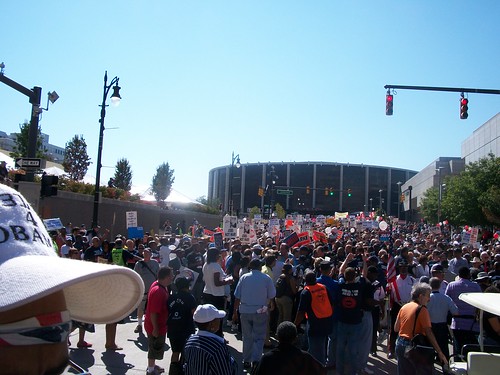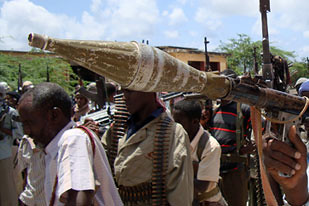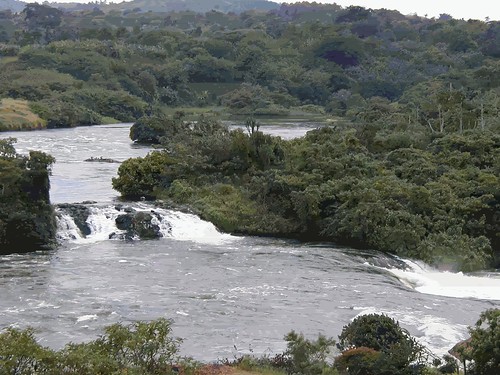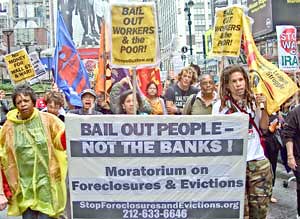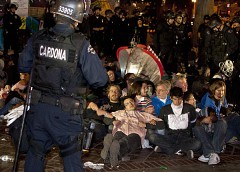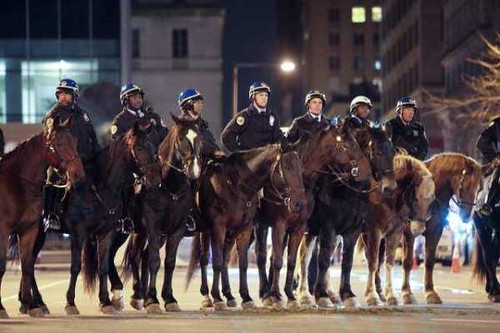The $7 trillion secret loan program
The government and big banks should be punished for deceiving the public about their hush-hush bailout scheme.
By Eliot Spitzer
Posted Wednesday, Nov. 30, 2011, at 1:34 PM ET
The government and the big banks deceived the public about their $7 trillion secret loan program. They should be punished.
Imagine you walked into a bank, applied for a personal line of credit, and filled out all the paperwork claiming to have no debts and an income of $200,000 per year. The bank, based on these representations, extended you the line of credit. Then, three years later, after fighting disclosure all the way, you were forced by a court to tell the truth: At the time you made the statements to the bank, you actually were unemployed, you had a $1 million mortgage on your house on which you had failed to make payments for six months, and you hadn’t paid even the minimum on your credit-card bills for three months. Do you think the bank would just say: Never mind, don’t worry about it? Of course not. Whether or not you had paid back the personal line of credit, three FBI agents would be at your door within hours.
Yet this is exactly what the major American banks have done to the public. During the deepest, darkest period of the financial cataclysm, the CEOs of major banks maintained in statements to the public, to the market at large, and to their own shareholders that the banks were in good financial shape, didn’t want to take TARP funds, and that the regulatory framework governing our banking system should not be altered. Trust us, they said. Yet, unknown to the public and the Congress, these same banks had been borrowing massive amounts from the government to remain afloat. The total numbers are staggering: $7.7 trillion of credit—one-half of the GDP of the entire nation. $460 billion was lent to J.P. Morgan, Bank of America, Citibank, Wells Fargo, Goldman Sachs, and Morgan Stanley alone—without anybody other than a few select officials at the Fed and the Treasury knowing. This was perhaps the single most massive allocation of capital from public to private hands in our history, and nobody was told. This was not TARP: This was secret Fed lending. And although it has since been repaid, it is clear why the banks didn’t want us to know about it: They didn’t want to admit the magnitude of their financial distress.
The banks’ claims of financial stability and solvency appear at a minimum to have been misleading—and may have been worse. Misleading statements and deception of this sort would ordinarily put a small-market player or borrower on the wrong end of a criminal investigation.
So where are the inquiries into the false statements made by the bank CEOs? And where are the inquiries about the Fed and Treasury officials who stood by silently as bank representatives made claims that were false, misleading, or worse?
Only now, because of superb analysis done by Bloomberg reporters—who litigated against the Fed and the banks for years to get the information—are we getting a full picture of the Fed and Treasury lending. The reporters also calculated that recipient banks and other borrowers benefited by approximately $13 billion simply by taking advantage of the “spread” between their cost of capital in these almost interest-free loans and their ability to lend the capital.
In addition to the secrecy, what is appalling is that these loans were made with no strings attached, no conditions, and no negotiation to achieve any broader public purpose. Even if one accepts the notion that the stability of the financial system could not be sacrificed, those who dispensed trillions of dollars to private parties made no apparent effort to impose even minimal obligations to condition the loans on the structural reforms needed to prevent another crisis, made no effort to require that those responsible for creating the crisis be relieved of their jobs, took zero steps towards the genuine mortgage-reform that is so necessary to begin a process of economic renewal. The dollars lent were simply a free bridge loan so the banks could push onto others the responsibility for the banks’ own risk-taking.
If ever there was an event to justify the darkest, most conspiratorial view held by many that the alliance of big money on Wall Street and big government produces nothing but secret deals that profit insiders—this is it.
So what to do? The revelations of the secret loan program may provide the opportunity for Occupy Wall Street to suggest a few concrete steps that would be difficult to oppose.
First: Demand a hearing where the bank executives have to answer questions—under oath—about the actual negotiations, or lack thereof, that led to these loans; about the actual condition of each of the borrowing banks and whether that condition differed from the public statements made by the banks at the time.
Second: Require the recipient banks to use this previously undisclosed gift—the profit they made by investing this almost interest-free money—to write down the value of mortgages of those who are underwater. The loans to the banks were meant to solve a short-term liquidity problem, not be a source of profits to fund bonuses. Take back the profits and put them to a public use.
Third: Require the government officials responsible for authorizing these loans to explain why there was no effort made to condition these loans on changes in policy that would protect the public going forward.
Fourth: Ask congress to examine every filing and statement made to Congress by the banks about their financial condition and their indebtedness to see if any misrepresentations were made in an effort to hide these trillions of dollars of loans. Misleading Congress can be a felony, and willful deception of the Congress to hide the magnitude of the public bailouts should not go unprosecuted.
Finally: Demand that politicians return all contributions made by the institutions that got hidden loans. Pressure the politicians who continue to feed from the trough of Wall Street, even as they know all too well how the banks and others have gamed the system and the public.
Secret Fed Loans Gave Banks $13 Billion Undisclosed to Congress
By Bob Ivry, Bradley Keoun and Phil Kuntz - Nov 27, 2011 Bloomberg Markets Magazine
The Federal Reserve and the big banks fought for more than two years to keep details of the largest bailout in U.S. history a secret. Now, the rest of the world can see what it was missing.
The Fed didn’t tell anyone which banks were in trouble so deep they required a combined $1.2 trillion on Dec. 5, 2008, their single neediest day. Bankers didn’t mention that they took tens of billions of dollars in emergency loans at the same time they were assuring investors their firms were healthy. And no one calculated until now that banks reaped an estimated $13 billion of income by taking advantage of the Fed’s below-market rates, Bloomberg Markets magazine reports in its January issue.
Saved by the bailout, bankers lobbied against government regulations, a job made easier by the Fed, which never disclosed the details of the rescue to lawmakers even as Congress doled out more money and debated new rules aimed at preventing the next collapse.
A fresh narrative of the financial crisis of 2007 to 2009 emerges from 29,000 pages of Fed documents obtained under the Freedom of Information Act and central bank records of more than 21,000 transactions. While Fed officials say that almost all of the loans were repaid and there have been no losses, details suggest taxpayers paid a price beyond dollars as the secret funding helped preserve a broken status quo and enabled the biggest banks to grow even bigger.
‘Change Their Votes’
“When you see the dollars the banks got, it’s hard to make the case these were successful institutions,” says Sherrod Brown, a Democratic Senator from Ohio who in 2010 introduced an unsuccessful bill to limit bank size. “This is an issue that can unite the Tea Party and Occupy Wall Street. There are lawmakers in both parties who would change their votes now.”
The size of the bailout came to light after Bloomberg LP, the parent of Bloomberg News, won a court case against the Fed and a group of the biggest U.S. banks called Clearing House Association LLC to force lending details into the open.
The Fed, headed by Chairman Ben S. Bernanke, argued that revealing borrower details would create a stigma -- investors and counterparties would shun firms that used the central bank as lender of last resort -- and that needy institutions would be reluctant to borrow in the next crisis. Clearing House Association fought Bloomberg’s lawsuit up to the U.S. Supreme Court, which declined to hear the banks’ appeal in March 2011.
$7.77 Trillion
The amount of money the central bank parceled out was surprising even to Gary H. Stern, president of the Federal Reserve Bank of Minneapolis from 1985 to 2009, who says he “wasn’t aware of the magnitude.” It dwarfed the Treasury Department’s better-known $700 billion Troubled Asset Relief Program, or TARP. Add up guarantees and lending limits, and the Fed had committed $7.77 trillion as of March 2009 to rescuing the financial system, more than half the value of everything produced in the U.S. that year.
“TARP at least had some strings attached,” says Brad Miller, a North Carolina Democrat on the House Financial Services Committee, referring to the program’s executive-pay ceiling. “With the Fed programs, there was nothing.”
Bankers didn’t disclose the extent of their borrowing. On Nov. 26, 2008, then-Bank of America (BAC) Corp. Chief Executive Officer Kenneth D. Lewis wrote to shareholders that he headed “one of the strongest and most stable major banks in the world.” He didn’t say that his Charlotte, North Carolina-based firm owed the central bank $86 billion that day.
‘Motivate Others’
JPMorgan Chase & Co. CEO Jamie Dimon told shareholders in a March 26, 2010, letter that his bank used the Fed’s Term Auction Facility “at the request of the Federal Reserve to help motivate others to use the system.” He didn’t say that the New York-based bank’s total TAF borrowings were almost twice its cash holdings or that its peak borrowing of $48 billion on Feb. 26, 2009, came more than a year after the program’s creation.
Howard Opinsky, a spokesman for JPMorgan (JPM), declined to comment about Dimon’s statement or the company’s Fed borrowings. Jerry Dubrowski, a spokesman for Bank of America, also declined to comment.
The Fed has been lending money to banks through its so- called discount window since just after its founding in 1913. Starting in August 2007, when confidence in banks began to wane, it created a variety of ways to bolster the financial system with cash or easily traded securities. By the end of 2008, the central bank had established or expanded 11 lending facilities catering to banks, securities firms and corporations that couldn’t get short-term loans from their usual sources.
‘Core Function’
“Supporting financial-market stability in times of extreme market stress is a core function of central banks,” says William B. English, director of the Fed’s Division of Monetary Affairs. “Our lending programs served to prevent a collapse of the financial system and to keep credit flowing to American families and businesses.”
The Fed has said that all loans were backed by appropriate collateral. That the central bank didn’t lose money should “lead to praise of the Fed, that they took this extraordinary step and they got it right,” says Phillip Swagel, a former assistant Treasury secretary under Henry M. Paulson and now a professor of international economic policy at the University of Maryland.
The Fed initially released lending data in aggregate form only. Information on which banks borrowed, when, how much and at what interest rate was kept from public view.
The secrecy extended even to members of President George W. Bush’s administration who managed TARP. Top aides to Paulson weren’t privy to Fed lending details during the creation of the program that provided crisis funding to more than 700 banks, say two former senior Treasury officials who requested anonymity because they weren’t authorized to speak.
Big Six
The Treasury Department relied on the recommendations of the Fed to decide which banks were healthy enough to get TARP money and how much, the former officials say. The six biggest U.S. banks, which received $160 billion of TARP funds, borrowed as much as $460 billion from the Fed, measured by peak daily debt calculated by Bloomberg using data obtained from the central bank. Paulson didn’t respond to a request for comment.
The six -- JPMorgan, Bank of America, Citigroup Inc. (C), Wells Fargo & Co. (WFC), Goldman Sachs Group Inc. (GS) and Morgan Stanley -- accounted for 63 percent of the average daily debt to the Fed by all publicly traded U.S. banks, money managers and investment- services firms, the data show. By comparison, they had about half of the industry’s assets before the bailout, which lasted from August 2007 through April 2010. The daily debt figure excludes cash that banks passed along to money-market funds.
Bank Supervision
While the emergency response prevented financial collapse, the Fed shouldn’t have allowed conditions to get to that point, says Joshua Rosner, a banking analyst with Graham Fisher & Co. in New York who predicted problems from lax mortgage underwriting as far back as 2001. The Fed, the primary supervisor for large financial companies, should have been more vigilant as the housing bubble formed, and the scale of its lending shows the “supervision of the banks prior to the crisis was far worse than we had imagined,” Rosner says.
Bernanke in an April 2009 speech said that the Fed provided emergency loans only to “sound institutions,” even though its internal assessments described at least one of the biggest borrowers, Citigroup, as “marginal.”
On Jan. 14, 2009, six days before the company’s central bank loans peaked, the New York Fed gave CEO Vikram Pandit a report declaring Citigroup’s financial strength to be “superficial,” bolstered largely by its $45 billion of Treasury funds. The document was released in early 2011 by the Financial Crisis Inquiry Commission, a panel empowered by Congress to probe the causes of the crisis.
‘Need Transparency’
Andrea Priest, a spokeswoman for the New York Fed, declined to comment, as did Jon Diat, a spokesman for Citigroup.
“I believe that the Fed should have independence in conducting highly technical monetary policy, but when they are putting taxpayer resources at risk, we need transparency and accountability,” says Alabama Senator Richard Shelby, the top Republican on the Senate Banking Committee.
Judd Gregg, a former New Hampshire senator who was a lead Republican negotiator on TARP, and Barney Frank, a Massachusetts Democrat who chaired the House Financial Services Committee, both say they were kept in the dark.
“We didn’t know the specifics,” says Gregg, who’s now an adviser to Goldman Sachs.
“We were aware emergency efforts were going on,” Frank says. “We didn’t know the specifics.”
Disclose Lending
Frank co-sponsored the Dodd-Frank Wall Street Reform and Consumer Protection Act, billed as a fix for financial-industry excesses. Congress debated that legislation in 2010 without a full understanding of how deeply the banks had depended on the Fed for survival.
It would have been “totally appropriate” to disclose the lending data by mid-2009, says David Jones, a former economist at the Federal Reserve Bank of New York who has written four books about the central bank.
“The Fed is the second-most-important appointed body in the U.S., next to the Supreme Court, and we’re dealing with a democracy,” Jones says. “Our representatives in Congress deserve to have this kind of information so they can oversee the Fed.”
The Dodd-Frank law required the Fed to release details of some emergency-lending programs in December 2010. It also mandated disclosure of discount-window borrowers after a two- year lag.
Protecting TARP
TARP and the Fed lending programs went “hand in hand,” says Sherrill Shaffer, a banking professor at the University of Wyoming in Laramie and a former chief economist at the New York Fed. While the TARP money helped insulate the central bank from losses, the Fed’s willingness to supply seemingly unlimited financing to the banks assured they wouldn’t collapse, protecting the Treasury’s TARP investments, he says.
“Even though the Treasury was in the headlines, the Fed was really behind the scenes engineering it,” Shaffer says.
Congress, at the urging of Bernanke and Paulson, created TARP in October 2008 after the bankruptcy of Lehman Brothers Holdings Inc. made it difficult for financial institutions to get loans. Bank of America and New York-based Citigroup each received $45 billion from TARP. At the time, both were tapping the Fed. Citigroup hit its peak borrowing of $99.5 billion in January 2009, while Bank of America topped out in February 2009 at $91.4 billion.
No Clue
Lawmakers knew none of this.
They had no clue that one bank, New York-based Morgan Stanley (MS), took $107 billion in Fed loans in September 2008, enough to pay off one-tenth of the country’s delinquent mortgages. The firm’s peak borrowing occurred the same day Congress rejected the proposed TARP bill, triggering the biggest point drop ever in the Dow Jones Industrial Average. (INDU) The bill later passed, and Morgan Stanley got $10 billion of TARP funds, though Paulson said only “healthy institutions” were eligible.
Mark Lake, a spokesman for Morgan Stanley, declined to comment, as did spokesmen for Citigroup and Goldman Sachs.
Had lawmakers known, it “could have changed the whole approach to reform legislation,” says Ted Kaufman, a former Democratic Senator from Delaware who, with Brown, introduced the bill to limit bank size.
Moral Hazard
Kaufman says some banks are so big that their failure could trigger a chain reaction in the financial system. The cost of borrowing for so-called too-big-to-fail banks is lower than that of smaller firms because lenders believe the government won’t let them go under. The perceived safety net creates what economists call moral hazard -- the belief that bankers will take greater risks because they’ll enjoy any profits while shifting losses to taxpayers.
If Congress had been aware of the extent of the Fed rescue, Kaufman says, he would have been able to line up more support for breaking up the biggest banks.
Byron L. Dorgan, a former Democratic senator from North Dakota, says the knowledge might have helped pass legislation to reinstate the Glass-Steagall Act, which for most of the last century separated customer deposits from the riskier practices of investment banking.
“Had people known about the hundreds of billions in loans to the biggest financial institutions, they would have demanded Congress take much more courageous actions to stop the practices that caused this near financial collapse,” says Dorgan, who retired in January.
Getting Bigger
Instead, the Fed and its secret financing helped America’s biggest financial firms get bigger and go on to pay employees as much as they did at the height of the housing bubble.
Total assets held by the six biggest U.S. banks increased 39 percent to $9.5 trillion on Sept. 30, 2011, from $6.8 trillion on the same day in 2006, according to Fed data.
For so few banks to hold so many assets is “un-American,” says Richard W. Fisher, president of the Federal Reserve Bank of Dallas. “All of these gargantuan institutions are too big to regulate. I’m in favor of breaking them up and slimming them down.”
Employees at the six biggest banks made twice the average for all U.S. workers in 2010, based on Bureau of Labor Statistics hourly compensation cost data. The banks spent $146.3 billion on compensation in 2010, or an average of $126,342 per worker, according to data compiled by Bloomberg. That’s up almost 20 percent from five years earlier compared with less than 15 percent for the average worker. Average pay at the banks in 2010 was about the same as in 2007, before the bailouts.
‘Wanted to Pretend’
“The pay levels came back so fast at some of these firms that it appeared they really wanted to pretend they hadn’t been bailed out,” says Anil Kashyap, a former Fed economist who’s now a professor of economics at the University of Chicago Booth School of Business. “They shouldn’t be surprised that a lot of people find some of the stuff that happened totally outrageous.”
Bank of America took over Merrill Lynch & Co. at the urging of then-Treasury Secretary Paulson after buying the biggest U.S. home lender, Countrywide Financial Corp. When the Merrill Lynch purchase was announced on Sept. 15, 2008, Bank of America had $14.4 billion in emergency Fed loans and Merrill Lynch had $8.1 billion. By the end of the month, Bank of America’s loans had reached $25 billion and Merrill Lynch’s had exceeded $60 billion, helping both firms keep the deal on track.
Prevent Collapse
Wells Fargo bought Wachovia Corp., the fourth-largest U.S. bank by deposits before the 2008 acquisition. Because depositors were pulling their money from Wachovia, the Fed channeled $50 billion in secret loans to the Charlotte, North Carolina-based bank through two emergency-financing programs to prevent collapse before Wells Fargo could complete the purchase.
“These programs proved to be very successful at providing financial markets the additional liquidity and confidence they needed at a time of unprecedented uncertainty,” says Ancel Martinez, a spokesman for Wells Fargo.
JPMorgan absorbed the country’s largest savings and loan, Seattle-based Washington Mutual Inc., and investment bank Bear Stearns Cos. The New York Fed, then headed by Timothy F. Geithner, who’s now Treasury secretary, helped JPMorgan complete the Bear Stearns deal by providing $29 billion of financing, which was disclosed at the time. The Fed also supplied Bear Stearns with $30 billion of secret loans to keep the company from failing before the acquisition closed, central bank data show. The loans were made through a program set up to provide emergency funding to brokerage firms.
‘Regulatory Discretion’
“Some might claim that the Fed was picking winners and losers, but what the Fed was doing was exercising its professional regulatory discretion,” says John Dearie, a former speechwriter at the New York Fed who’s now executive vice president for policy at the Financial Services Forum, a Washington-based group consisting of the CEOs of 20 of the world’s biggest financial firms. “The Fed clearly felt it had what it needed within the requirements of the law to continue to lend to Bear and Wachovia.”
The bill introduced by Brown and Kaufman in April 2010 would have mandated shrinking the six largest firms.
“When a few banks have advantages, the little guys get squeezed,” Brown says. “That, to me, is not what capitalism should be.”
Kaufman says he’s passionate about curbing too-big-to-fail banks because he fears another crisis.
‘Can We Survive?’
“The amount of pain that people, through no fault of their own, had to endure -- and the prospect of putting them through it again -- is appalling,” Kaufman says. “The public has no more appetite for bailouts. What would happen tomorrow if one of these big banks got in trouble? Can we survive that?”
Lobbying expenditures by the six banks that would have been affected by the legislation rose to $29.4 million in 2010 compared with $22.1 million in 2006, the last full year before credit markets seized up -- a gain of 33 percent, according to OpenSecrets.org, a research group that tracks money in U.S. politics. Lobbying by the American Bankers Association, a trade organization, increased at about the same rate, OpenSecrets.org reported.
Lobbyists argued the virtues of bigger banks. They’re more stable, better able to serve large companies and more competitive internationally, and breaking them up would cost jobs and cause “long-term damage to the U.S. economy,” according to a Nov. 13, 2009, letter to members of Congress from the FSF.
The group’s website cites Nobel Prize-winning economist Oliver E. Williamson, a professor emeritus at the University of California, Berkeley, for demonstrating the greater efficiency of large companies.
‘Serious Burden’
In an interview, Williamson says that the organization took his research out of context and that efficiency is only one factor in deciding whether to preserve too-big-to-fail banks.
“The banks that were too big got even bigger, and the problems that we had to begin with are magnified in the process,” Williamson says. “The big banks have incentives to take risks they wouldn’t take if they didn’t have government support. It’s a serious burden on the rest of the economy.”
Dearie says his group didn’t mean to imply that Williamson endorsed big banks.
Top officials in President Barack Obama’s administration sided with the FSF in arguing against legislative curbs on the size of banks.
Geithner, Kaufman
On May 4, 2010, Geithner visited Kaufman in his Capitol Hill office. As president of the New York Fed in 2007 and 2008, Geithner helped design and run the central bank’s lending programs. The New York Fed supervised four of the six biggest U.S. banks and, during the credit crunch, put together a daily confidential report on Wall Street’s financial condition. Geithner was copied on these reports, based on a sampling of e- mails released by the Financial Crisis Inquiry Commission.
At the meeting with Kaufman, Geithner argued that the issue of limiting bank size was too complex for Congress and that people who know the markets should handle these decisions, Kaufman says. According to Kaufman, Geithner said he preferred that bank supervisors from around the world, meeting in Basel, Switzerland, make rules increasing the amount of money banks need to hold in reserve. Passing laws in the U.S. would undercut his efforts in Basel, Geithner said, according to Kaufman.
Anthony Coley, a spokesman for Geithner, declined to comment.
‘Punishing Success’
Lobbyists for the big banks made the winning case that forcing them to break up was “punishing success,” Brown says. Now that they can see how much the banks were borrowing from the Fed, senators might think differently, he says.
The Fed supported curbing too-big-to-fail banks, including giving regulators the power to close large financial firms and implementing tougher supervision for big banks, says Fed General Counsel Scott G. Alvarez. The Fed didn’t take a position on whether large banks should be dismantled before they get into trouble.
Dodd-Frank does provide a mechanism for regulators to break up the biggest banks. It established the Financial Stability Oversight Council that could order teetering banks to shut down in an orderly way. The council is headed by Geithner.
“Dodd-Frank does not solve the problem of too big to fail,” says Shelby, the Alabama Republican. “Moral hazard and taxpayer exposure still very much exist.”
Below Market
Dean Baker, co-director of the Center for Economic and Policy Research in Washington, says banks “were either in bad shape or taking advantage of the Fed giving them a good deal. The former contradicts their public statements. The latter -- getting loans at below-market rates during a financial crisis -- is quite a gift.”
The Fed says it typically makes emergency loans more expensive than those available in the marketplace to discourage banks from abusing the privilege. During the crisis, Fed loans were among the cheapest around, with funding available for as low as 0.01 percent in December 2008, according to data from the central bank and money-market rates tracked by Bloomberg.
The Fed funds also benefited firms by allowing them to avoid selling assets to pay investors and depositors who pulled their money. So the assets stayed on the banks’ books, earning interest.
Banks report the difference between what they earn on loans and investments and their borrowing expenses. The figure, known as net interest margin, provides a clue to how much profit the firms turned on their Fed loans, the costs of which were included in those expenses. To calculate how much banks stood to make, Bloomberg multiplied their tax-adjusted net interest margins by their average Fed debt during reporting periods in which they took emergency loans.
Added Income
The 190 firms for which data were available would have produced income of $13 billion, assuming all of the bailout funds were invested at the margins reported, the data show.
The six biggest U.S. banks’ share of the estimated subsidy was $4.8 billion, or 23 percent of their combined net income during the time they were borrowing from the Fed. Citigroup would have taken in the most, with $1.8 billion.
“The net interest margin is an effective way of getting at the benefits that these large banks received from the Fed,” says Gerald A. Hanweck, a former Fed economist who’s now a finance professor at George Mason University in Fairfax, Virginia.
While the method isn’t perfect, it’s impossible to state the banks’ exact profits or savings from their Fed loans because the numbers aren’t disclosed and there isn’t enough publicly available data to figure it out.
Opinsky, the JPMorgan spokesman, says he doesn’t think the calculation is fair because “in all likelihood, such funds were likely invested in very short-term investments,” which typically bring lower returns.
Standing Access
Even without tapping the Fed, the banks get a subsidy by having standing access to the central bank’s money, says Viral Acharya, a New York University economics professor who has worked as an academic adviser to the New York Fed.
“Banks don’t give lines of credit to corporations for free,” he says. “Why should all these government guarantees and liquidity facilities be for free?”
In the September 2008 meeting at which Paulson and Bernanke briefed lawmakers on the need for TARP, Bernanke said that if nothing was done, “unemployment would rise -- to 8 or 9 percent from the prevailing 6.1 percent,” Paulson wrote in “On the Brink” (Business Plus, 2010).
Occupy Wall Street
The U.S. jobless rate hasn’t dipped below 8.8 percent since March 2009, 3.6 million homes have been foreclosed since August 2007, according to data provider RealtyTrac Inc., and police have clashed with Occupy Wall Street protesters, who say government policies favor the wealthiest citizens, in New York, Boston, Seattle and Oakland, California.
The Tea Party, which supports a more limited role for government, has its roots in anger over the Wall Street bailouts, says Neil M. Barofsky, former TARP special inspector general and a Bloomberg Television contributing editor.
“The lack of transparency is not just frustrating; it really blocked accountability,” Barofsky says. “When people don’t know the details, they fill in the blanks. They believe in conspiracies.”
In the end, Geithner had his way. The Brown-Kaufman proposal to limit the size of banks was defeated, 60 to 31. Bank supervisors meeting in Switzerland did mandate minimum reserves that institutions will have to hold, with higher levels for the world’s largest banks, including the six biggest in the U.S. Those rules can be changed by individual countries.
They take full effect in 2019.
Meanwhile, Kaufman says, “we’re absolutely, totally, 100 percent not prepared for another financial crisis.”
To contact the reporters on this story: Bob Ivry in New York at bivry@bloomberg.net; Bradley Keoun in New York at bkeoun@bloomberg.net; Phil Kuntz in New York at pkuntz1@bloomberg.net.
To contact the editors responsible for this story: Gary Putka at gputka@bloomberg.net; David Scheer at dscheer@bloomberg.net.
Secret Funding Made Big Banks Bigger
November 29, 2011 at 3:16 PM
Using FOIA, Bloomberg Obtains 29,000 Pages of Fed Papers
"The Federal Reserve and the big banks fought for more than two years to keep details of the largest bailout in U.S. history a secret [34]. Now, the rest of the world can see what it was missing," Bob Ivry, Bradley Keoun and Phil Kuntz of Bloomberg Markets magazine reported on Sunday.
"The Fed didn't tell anyone which banks were in trouble so deep they required a combined $1.2 trillion on Dec. 5, 2008, their single neediest day. Bankers didn't mention that they took tens of billions of dollars in emergency loans at the same time they were assuring investors their firms were healthy. And no one calculated until now that banks reaped an estimated $13 billion of income by taking advantage of the Fed's below-market rates, Bloomberg Markets magazine reports in its January issue.
"Saved by the bailout, bankers lobbied against government regulations, a job made easier by the Fed, which never disclosed the details of the rescue to lawmakers even as Congress doled out more money and debated new rules aimed at preventing the next collapse.
"A fresh narrative of the financial crisis of 2007 to 2009 emerges from 29,000 pages of Fed documents obtained under the Freedom of Information Act and central bank records of more than 21,000 transactions. While Fed officials say that almost all of the loans were repaid and there have been no losses, details suggest taxpayers paid a price beyond dollars as the secret funding helped preserve a broken status quo and enabled the biggest banks to grow even bigger.
" 'When you see the dollars the banks got, it's hard to make the case these were successful institutions,' says Sherrod Brown, a Democratic Senator from Ohio who in 2010 introduced an unsuccessful bill to limit bank size. 'This is an issue that can unite the Tea Party and Occupy Wall Street. There are lawmakers in both parties who would change their votes now.'
"The size of the bailout came to light after Bloomberg LP, the parent of Bloomberg News, won a court case against the Fed and a group of the biggest U.S. banks called Clearing House Association LLC to force lending details into the open."
Central Banks Aim Bazooka Of Cheap Dollars At European Banks
Slate.com
I published a column yesterday about some relative recent academic research which suggests that deleveraging by European banks could have a drastic contractionary impact on credit conditions in the United States. One possible solution to that, being implemented today by the Federal Reserve Bank in coordination with other major central banks, is to drastically lower the price that foreign central banks have to pay to obtain dollars. Then those central banks can pass the cheap dollars on to the banks they supervise. Will this work? Is it fair? Is it a good idea?
THE GOOD: In terms of credit conditions in the United States, this should work. Foreign banks hold about half the dollars in circulation, and they make loans based on those holdings. Those loans largely go to American households or firms operating in the United States since this, at the end of the day, is where you buy things with dollars. If they started hoarding dollars instead of using them as the basis for loans, that would have thrown a ton of sand into the gears of the American economy.
THE BAD: This appears to be driving the Euro/Dollar exchange rate up which is going to make the underlying economic problems in Spain, Italy, Greece, Portugal, and even France worse. There's still a need for the European Central Bank to target sovereign debt yields and for Germany to consider buying more stuff as an appealing alternative to bailouts. Meanwhile it continues to be the case that both the Fed and the ECB would do well to start adopting more growth-oriented targets for medium-term monetary policy. All these sporadic "emergency" actions leave everyone scratching their heads about the future.
THE UGLY: As with the Federal Reserve's secret lending to American banks in late 2008 actions of this sort raise fundamental issues about fairness. Handing out cheap money to European banks will help bolster them, which will help stabilize the economy. But the exact same logic applies to all sorts of distressed institutions in the world today. Where's the free money for American municipalities? Where's the free money for debt-constrained households? Beyond the operational details, where's the targeting of full employment? In its November meeting, the Fed's Open Market Committee rejected NGDP targeting as too risky and unorthodox to be worth trying even though it might create millions of new jobs. Then European banks run into trouble, and suddenly nobody cares about being risky and unorthodox.
At the end of the day the conjunction of these kind of actions with continued inability to return us to full employment makes it all but inevitable that the "End The Fed" crowd's voices are going to grow louder. The world's central banks badly need to wake up and realize that it's time to go "all in" on doing everything the possibly can to solve the developed world's demand shortfall.
